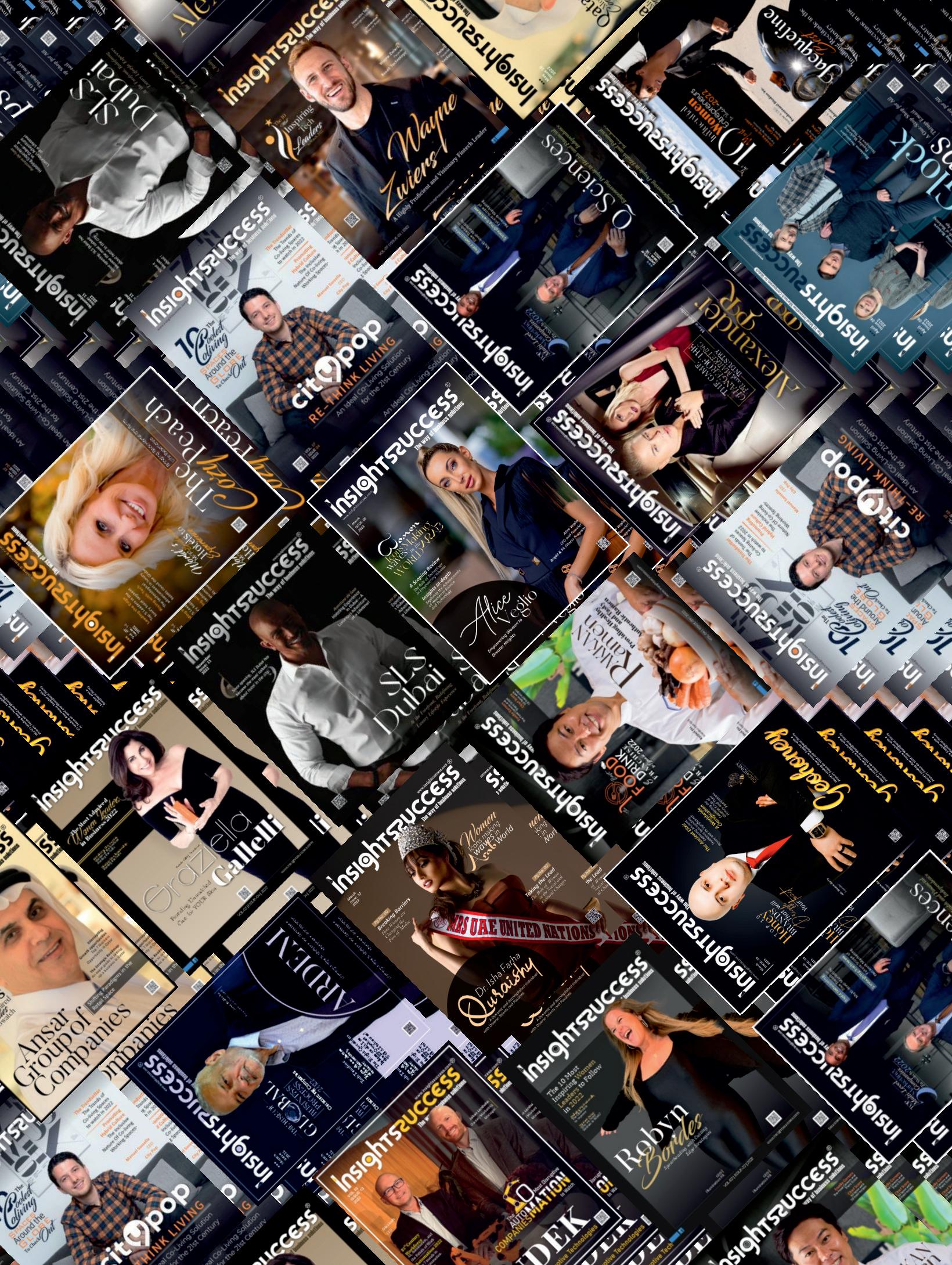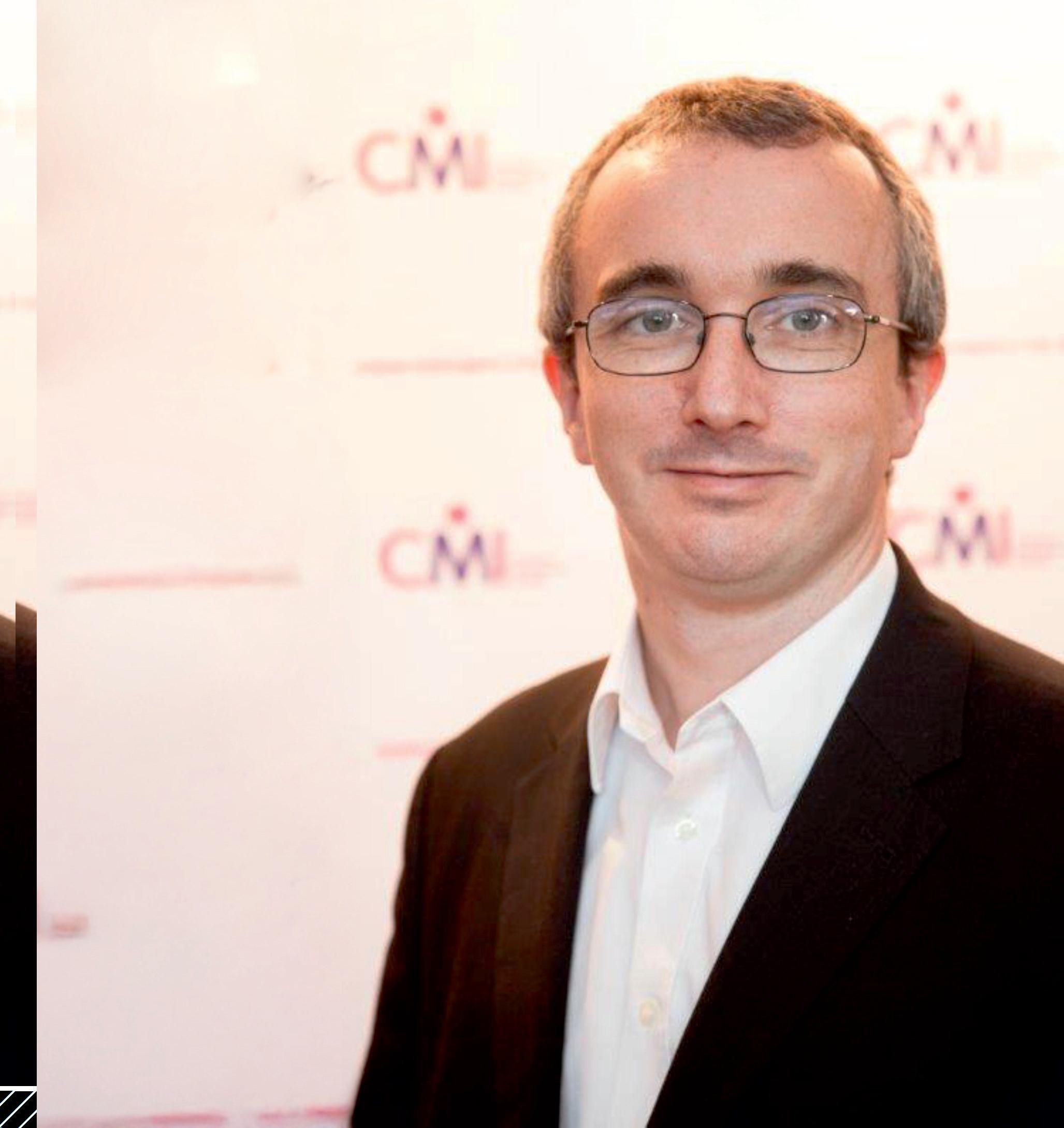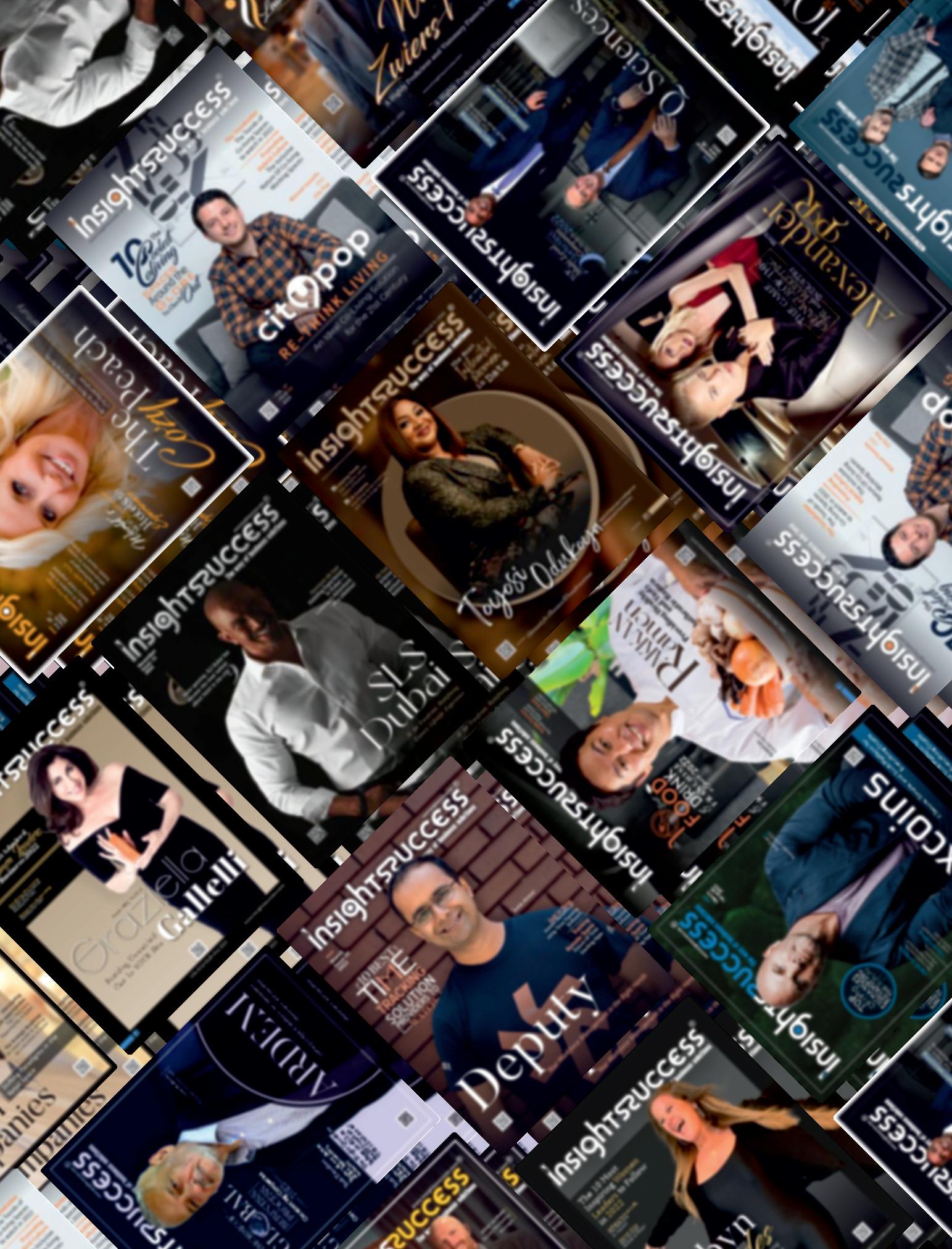

ADMIRED PERSONALITY




Editorial
-Alaya Brown
A Tribute to Visionary Impact
As we continue into a year shaped by resilience,
innovation,andhumanpotential,weareproudto present our special edition of Insights Success titled:MostAdmiredPersonalitytoWatchin2025.Atthe heart of this edition is an individual who exemplifies all threequalitiesPaulTaylor.
Paul’s story is not just one of success, but of relentless pursuit Whether through transformative leadership, community impact, or visionary thinking, he has consistently elevated those around him while redefining what it means to lead with purpose. In a time where authenticity is more valuable than authority, Paul brings both to the table in equal measure. His work spans industriesandideologiesyetremainsgroundedinasingle principle:peoplefirst.
Thiseditionismorethanacelebrationofachievementsit’s an invitation to observe, learn, and be inspired by a trailblazer whose best work is yet to come. Through exclusiveinsights,reflectionsfrompeers,andadeepdive into his professional and personal journey, we explore what makes Paul Taylor not just admired, but genuinely influentialinthefabricoftoday’sevolvingworld.
To be admired is one thing To consistently inspire admirationthroughintegrity,impact,andinnovationthat’s rare. As the world watches for change-makers who not only talk about the future but help build it, Paul Taylor standsattheforefront.Wehopethiseditionleavesyouas inspiredaswewereputtingittogether
HappyReading!

Paul Taylor
The Architect of Agile Leadership and Lifelong Learning
ARTICLES
16
Adaptive Leadership Strategies for Navigating Digital Transformation in Traditional Industries
18
Leadership Through Learning for Digital Transformation

Business
Business












PAUL TAYLOR
The Architect of Agile Leadership and Lifelong Learning

“Don’t lose the big picture, even when you’re stuck in the weeds.”




Most Admired Personality to Watch in 2025
Someprofessionalsareresilientandabletoadapt,while others drive change. Paul Taylor belongs unapologetically to the latter group. He has built a multifaceted career over the past 35 years that marries technology, leadership, instruction, and human connection. His journey from the backwaters of IT departments to the boardroom,theclassroom,andthekeynotestageisn'tjustthe quintessentialsuccessstory;it'samasterclassinreinvention, motivation,andleadership.
As a widely recognised NED, strategic adviser, change manager,technologyleader,andlecturer,Paulisinfluencing sectorsincludingfinancialservices,fintech,education,health andwellbeing,andothers.Whetherheisleadingacompanywidechangeprocessatablue-chipcorporationorcoachinga youngprofessionaltofindtheirsealegs,Pauldrawsuponthe four sigma principles that establish his foundation: honesty, inquisitiveness,accountability,andlifelonglearning.
HumbleBeginnings-ACareerSparkedbyCuriosity
He began his career in 1988 at a Private Bank in London, where he worked in the InformationTechnology division as both a Business Analyst and a Programmer. If it was a customary point of departure, Paul soon showed an exceptional way: one powered by intellectual enthusiasm, a fascinationwithdetail,andareadinesstomakeadifference.
Hisinsatiableappetiteforsystemsthinkingofboththehuman and technological kind saw him transatlantic bound for investmentmanagementintheUK,workinginitiallybetween theirLondonandEdinburghoffices.AndtherePaulwasinthe middle of an expanding business. That growth-heavy environment was the crucible for Paul’s growth as a leader, with responsibilities ranging from team building and tech development to strategic planning. He left the company as Head of European Technology Development within this majorsubsidiary,ahigh-flyingpost,butonethatalsocaused muchinnerstrife.
“As I moved to management, I found I was pulling away from that detail. I came to see that I missed being close to the work itself,thepartwherechangeistrulymade,”hesays.
Thisrealisation,whichcouldnolongerbehiddeninhonesty, iswhatgotthegearsofchangeturning.
TheFreelancer’sLeap-BreakingtheMouldin2007
In 2007, driven by a desire to return to the tactile work he enjoyedandre-establishhimselfasanindividualcontributor,

“My job is to help my client succeed, some�mes that means challenging them, not just agreeing with them.”
hetookabigleapbyquittinghisfull-timejobandembarking onacareerasafreelanceconsultant.Whatothersmighthave seenasaprofessionalgamblewas,forPaul,aninevitablenext runginalifespentdeliberatelyexpandinghisabilities.
His first interim IT manager assignment at an oil company swiftlyledtoasecondasprogrammanageratoneoftheUK’s largest pension funds.And each role not only contributed to his experience but also deepened his belief in project-based, purpose-drivenwork.
Ashisfreelancecareerevolved,Paulbegantoredefinewhat success meant. Instead of titles or ladders, he sought a portfolio career, a way to advise, teach, write, and mentor acrossvariousareas.
TheProfessionalPortfolio-AModelforModernWork
Today, Paul stands as a sterling example of a successful portfolioprofessional.Hiscareerencompasses-
• Chair and Non-Executive Director roles across the UK andinternationalorganisations
• Strategic advisory to fintech start-ups, educational organisations,andwellbeinginitiatives
• Associate Lecturer in Technology Management at the UK’sOpenUniversity
• Guest lecturer and speaker at leading universities and conferences
• Published author, with regular contributions to blogs, books,andindustrypublications
• Mentor to over 30 professionals, guiding them through careertransitions,leadershipdevelopment,andpersonal challenges
What binds these roles together is value creation. Whether leadingagovernanceframeworkormentoringamentee,Paul approaches each opportunity with a focus on creating sustainable,measurableimpact.
Work-LifeHarmony-AConsciousDesign
Though many workforce professionals struggle with the balance,Paulviewsitasconscientiousdisciplinethatisbotha functionofstructureandself-awareness.

“As I moved to management, I found I was pulling away from that detail. I came to see that I missed being close to the work itself, the part where change is truly made.”
His daily routine is structured to facilitate deep work, client interactions,andpersonalgrowth.
Paul’s following his advice, from early morning to planning andtime-blockingforfamilyandreflection.
He schedules his own time off in advance, protects his weekends, and believes in prioritisation and anticipation management.As he likes to say, “You can’t do everything at once, and people respect you more when you’re honest about that.”
BusinessWithPurpose-ServingClientsandSociety
AtthecoreofPaul’sprofessionalphilosophyisasimpleethic: serveyourclientswellandyouservesocietywell.
Whether it’s with an international corporation or a college student, Paul brings a wealth of commitment and accountability “My job is to help my client succeed, sometimes that means challenging them, not just agreeing with them.”hesays.Thatattitudehaswonhimtheconfidence ofbothestablishedleadersandrisingentrepreneurs.
Hispassionforbusinessisn'tdrivenbymoney;it'srootedina mission.Hedesirestolearn,makeadifference,andimprove thesystem.Thishungerknowsnobounds,reachingacrossto new industries, trending technologies, and changing human trends.“Idon’tchasebusiness.Ichasebetter,”hesays.
ResilienceinUncertainty-LessonsfromthePandemic
Unlike much else, Paul moved with grace throughout the COVID-19 pandemic. As he had already adopted remote work,thechangeofworkstylewasasmallburden.Thereal challenge, he believes, was structuring work around the evolving needs of others, especially as his colleagues dealt withnewsourcesoffamilyandpersonalstress.
Whatfueledhissuccesswasadeep-downadaptability,i.e.,a willingnesstochangeformwithoutlosinghisfocus.ForPaul, thepandemicreaffirmedaconvictionhehaslongheld“The abilitytoadaptisn'toptional.It'sessential.”
StrengthsandShadows-TheHumanSideofSuccess
PaulTaylorisamanofprinciples,responsibility,loyalty,and quality that is eternally unwavering. He is known for being someonewhocanalwaysbecountedontotaketheballover the goal line, leading to a sense of confidence and peace amongstclientsandcolleagues.

“Your team needs clarity, not chaos. Always be learning. Leadership begins where ego ends.”
The analytical approach to programming he learned in his earlyyearsasaprogrammerhaslefthimwithanappetitefor foresightandaclearmethodofcommunication,bothofwhich remaintwoofhisgreatestassets.
But Paul is also aware that he must balance depth with perspective,figuringoutatthesametimewhentotakeastep backandlookattheforestinsteadofjustthetree.
Butstructured,analytic,andmethodical,Paulimposesorder on chaos even if, as he admits, excessive governance can bringaprojecttoasnail’scrawl.He’sadjustedbylearningto adapt his pants to new environments. One of his greatest evolutions has been learning to delegate — from doing everything by himself to learning to trust others. For Paul, leadership isn’t about knowing all the answers, but about learning,evolving,andconsistentlyreturningtoagrounded, values-basedperspective.
MilestonesThatMattered
Throughouthisextensivecareer,Paulhascelebratedseveral landmarkmoments:
• 1995:Successfullymanagedhisfirstindependentproject - a confidence-building achievement that shifted his trajectorytowardleadership.
• 1999: Earned his MBA from the Open University, bridgingaperceived“academicgap”andexpandinghis strategicperspective.
• 2007: Leaped into freelance consulting, a pivotal decision that brought autonomy and personal satisfaction.
• 2013: Secured his first Non-Executive Director and board advisor roles, crystallising his transition into a portfoliocareer
• 2018: Became a lecturer at the Open University, an enriching experience that allowed him to inspire and supportthenextgeneration.
Each of these milestones speaks to his values: courage, growth,andgivingback.
ThePassionThatFuelsHim
For Paul Taylor, it’s not about prestige or power, it’s about purpose But underpinning his journey is a rock-solid dedication to doing right by his clients, even when that involves questioning their assumptions or telling them uncomfortabletruths.


“Always do your best. Keep learning. Be a nice person. Nice guys do finish well.”
Conciliationisneverhisaim;heaimstobevalue-addingand help take people to better places. Just as central to his enthusiasmisaninsatiablecommitmenttoself-development.
Being up to date on business, technology, and societal changesisnotjustaboutkeepinghisprofessionalskillssharp; itmakeshimamorethoughtfulandadaptableleader Whether he’slearningbydoing,readingbooks,researching,orsimply lookingatthosearoundhim,Paulbelievesthatknowledgeisa renewable source; it becomes exponentially more valuable whenshared.
LeadershipAdviceforaNewEra
Asked for his advice to rising leaders, Paul Taylor doesn’t defaulttoclichés.Instead,he’sasobermixofpragmatismand principle. “First, build trust, both within the team and with yourself, ” he says, emphasising that, as with strong leadership, everything starts with the basics. He argues for leading through structure, but with enough flexibility to adjust. Against becoming bogged down in the detail at the expense of the larger mission, “Don’t lose the big picture, evenwhenyou’restuckintheweeds.”
ToPaul,leadershipisalsoamatterofcharacter,ashesetsthe example through the integrity, humility, and approachability he brings to his role. And in especially difficult times, he thinks the best response is a calm one: “Your team needs clarity, not chaos. Always be learning. Leadership begins whereegoends.”heshares.
LifeRootedinValues
Withahigh-profileportfolioandabusyprofessionallife,Paul is an advocate of what could be described as a simpler approach:
“Beethical.Becurious.Bekind,”heshares.
It’s asentimentthatruns deepthroughhiswork andhislife. FromstudentstoCEOsandboardmembers,PaulTayloristhe rareprofessionalwhocutsacrosshierarchiesandindustries.
PaulisafigureforeverrowingagainstthetideintheKingdom ofNoise.Givenourself-promotingage,heisamanofquiet leadership. And in a business culture drunk on short-term gains,heeschewsthatethosforafocusonlong-termchange.
TheLegacyofaLifetimeLearner
PaulTaylormaynotcovetaccoladesorthelimelight,buthis impactisinescapable.Overdecades,ashehasevolvedfrom programmingtoprojectleadership,fromadvisertoeducator, he has become a lighthouse for projects seeking not just successbutmeaning.
Hisportfoliocareerisnotjustacareermodel;it’sablueprint fordoingmeaningful,principledworkinthe21stcentury
Andhismessagetoanyonereading?“Always do your best. Keeplearning.Beaniceperson.Niceguysdofinishwell.”


ADAPTIVE LEADERSHIP STRATEGIES FOR NAVIGATING TRADITIONAL INDUSTRIES DIGITAL TRANSFORMATION IN

In the pace of the modern age today, old industries from manufacturing and transportation to healthcare and finance are shattered by swift-breaking technologies. Exciting as innovation is, it poses gigantic challenges, especially to firms founded on deeply entrenched habits of practice.Tosurviveandcompete,thesefirmsrequirenotjust new technology but also fresh thinking and new leadership styles.Thatiswhereadaptiveleadershippracticesstepin.
UnderstandingAdaptiveLeadership
Adaptiveleadership,bydefinition,isaboutleadingwithouta roadmap,embracinguncertainty,andinspiringindividualsto work on difficult problems. As opposed to authoritative or transactional leadership, adaptive leadership is not necessarilyfoundedonexpertiseorhierarchicalrank.Rather, it requires adaptability, emotional intelligence, and collaboration.Adaptiveleadershippractitionersknowthatthe solutions are most frequently not linear and involve experiment and error, learning, and reconvening along the way.
Thisisespeciallycrucialtolegacyindustries,whichallshare the common deficiency of legacy systems, cultural lag, and heterogeneityofregulation.
TheDigitalDisruptionDilemma
Digital transformation's not as much about standing up new software or automating things it's about changing how an organization creates value. Old-line organizations have a lot of work to do on this one. They're typically burdened with legacyinfrastructure,processesthatarehighlyingrained,and people who're accustomed to the way things have always been.
Forinstance,amanufacturingcompanymayinvestinInternet of Things (IoT) sensors and artificial intelligence-based quality control software. But if the right mindset and leadershiparelacking,suchtoolswouldbefoughtagainstor underutilized completely It is because of this reason that adaptiveleadershipstrategiesareofutmostimportanceonly they assure that systems and individuals transform simultaneously
ImportantFeaturesofAdaptiveLeadershipStrategies 1.EstablishingaCultureofLearningandUnlearning
Successful leaders are aware that digital transformation is a continuous process They create an environment where learningisnotonlythenormbutalsomandatory

No less important is the ability to unlearn previous habits whicharenolongerbenefitingtheorganization.
For example, a legacy bank digitizing its customer service portals must enable its employees to say goodbye to paper processing and move to digital workflows Adaptive leadership facilitates this change through encouraging open communication, training, and rewarding incremental achievements.
2.EnablingStakeholdersatAllLevels
Youcan'tleadchangefromthetopdown.Adaptiveleadership behaviorsareallaboutmakingsureemployeesateverylevel feel empowered to contribute suggestions, voice concerns, andtakeownershipofchange.Democratizationofinnovation notonlyengagesmorepeoplebutalsoyieldsgreatideasfrom thosemostintimatewithdailywork.
Effective leaders of old-line industries conduct regular forums, use technology-facilitated collaboration tools, and engageopencommunicationtodispelsilosandbuildtrust.
3.ReassuringStabilityandInnovation
Change, while it needs innovation, requires legacy firms to maintain operational stability that sustains their core products Adaptive leadership is not asking for radical transformation;itrejectsdumbandout-of-strategic-priorities risk-taking.
Itisdonewherethefirmprioritizescomplianceandsafetyat all costs even when it introduces new technologies like telemedicine andAI diagnostics.Adaptive leaders pilot test innovationsinacontrolledenvironmentbeforedeployingitin thewholefirm.
4.EmotionalIntelligence
Change creates fear, doubt, and resistance—especially in established industries. Adaptive leaders confront those emotionalresponseswithcompassion.Theylistencarefully, acknowledge fears, and guide groups through uncertainty withpatienceandwillingnesstohear
Emotional intelligence is not a "soft skill" it's a core competenceforleadinginunstable,uncertain,complex,and ambiguous (VUCA) world. By understanding human dynamics,adaptiveleaderscandevelopresilientteamsmore receptivetochange.
5.LeveragingDatatoInformandAdapt
Digital transformation generates high volumes of data Adaptive leadership behaviors include applying the data not only to make informed decisions, but also to adapt in realtime.Ifarecentlylauncheddigitalplatformisn'tperforming as anticipated, adaptive leaders study the metrics, note the gaps,andadjustquickly
This would mean, in companies where trades are not involved, monitoring live dashboards of supply chains or reviewingthefreshcustomerfeedbackgeneratedfromdigital interfacesrolledoutintherecenttime.
CaseinPoint:TheMakeoverofaLegacyManufacturer
Take the example of a 70-year-old textile mill that was computerized at the expense of its international competitiveness. The initial measures were to put in place advancedmachineryandERPsoftware.Theydidnotseeany meaningful improvements in productivity and efficiency. It wasonlywhenthemanagementadoptedadaptiveleadership practices creating cross-functional workshops, reengineering KPIs, and putting in place peer mentorship programs—thatchangebecameareality
Within twelve months, production cycles reduced, employees' morale improved, and customer satisfaction levels increased. Listening, pivoting, and iterating were the magickeysthatturnedthechangearound.
Conclusion: Leading Through Change with Agility and
Empathy
During a time in life when digital transformation cannot be avoided, resilience is the biggest competitive advantage. Legacysectorshavetheoddsagainstthem,butwiththeright leadershipapproach,theynotonlysurvivebutthrive.
Adaptive leadership is less about having answers in mind—it'smoreaboutposingtherightquestions,learningon the fly, and leading from the heart. Adopting these ideas, leadersinmoreconventionalfirmscanweatherthestormof digital disintegration while keeping intact virtues that made themsuccessfulinthefirstplace.
Asthefuturecontinuestounfoldinunexpectedmanner,itwill notbethestrongestorthemosttechnologicallyadvancedone leadingtheway—itwillbethemostresilient.


Inthisageofartificialintelligence,automation,andnon-
stop innovation, digital transformation is no longer a choice,it'sanecessity Organizationsgloballyareracing to transform processes, redefine customer experiences, and automate operations with digital technologies. Yet behind every successful transformation is something more intrinsic than technology itself: humans. And specifically, leaders embracing leadership through learning as the platform of changethatlasts.
Digitaltransformationisnotaone-nightstand.Itisalengthy company-wide transformation that changes value creation andvaluedelivery.Togainmomentum,forsuchanevolution to occur, businesses require leaders who are receptive to transformation and also dedicated to ongoing learning and growthalongtheway
That's what sets transformative leadership apart from conventionalmanagement,leadershipthroughlearningisnot atool;it'samindset.
Why Digital Transformation Calls for a New Model of Leadership?
Thedigitaleraoftodayhasmademostleadershipplaybooks of the past irrelevant. Static frameworks, fixed knowledge, and command-and-control no longer apply when technologies change overnight, customer needs change overnight,andcompetitioncancomefromanywhere.
In this unpredictable setting, leaders need to learn quicker than change They cannot depend only on historical experience when making choices; they need to remain alert, responsive,andfullyengagedtonewtrendsandtools.More importantly, they have to develop a culture that honors learning, fosters experimentation, and regards failure as a steppingstonetoinnovation.
Learningleadershipprovidesjustthat.Itrendersleadersmore open-minded,humble,andseechallengesasathreatnot,but learning opportunities. In the process, they impart the same mindsetintheirteams,makingcompanieswhicharenotonly digitallyenabledbutindeedtransformation-capable.
LearningasaLeadershipCompetency
Leadershiphad,foralongperiodoftime,beensynonymous with knowingness, surety, and authority But today, with the digital age, those are being redefined. The best leaders are thosewhoknowwhattheydon'tknowandseekoutwhatthey do need to know in order to grow. They learn from others, welcomecriticism,andbendwhenconditionschange.
Thisway,thisstylebecomesbelievableandauthentic.When the people witnessing their supervisors learning in action—whetheritissolvingproblemswithnewtechnology, interactingwithcustomersinnewways,orre-examiningpast strategies, their employees are much more likely to do so as well.Learningisacontagion.
And third, when leaders embody continuous learning, they communicate to employees that progress is more important than perfection This paradigm allows teams to make educated risks, provide innovative suggestions, and savor authentic problem-solving With this kind of culture, innovation thrives, and change is not only possible but sustainable.
MakingLearningaCulturalHabit
Rolling out new technology is comparatively simple Challengingfundamentallyistochangethewaypeoplethink, work,andinteractwithoneanother Thatiswhydevelopinga culture of learning—led by the leadership—is essential for digitaltransformationsuccess.
It begins with little things: managers recognizing when they don't understand something new on a platform, seeking answersratherthandictatingtoothers,ortradingadvicefrom a recent class or conference. These tiny-sounding actions speakvolumes:learningissimplypartofthejob,regardless ofwhatyourjobtitleis.
As time passes, these ways of behaving come to define the organization'sculture.Curiosityisworthmorethandegrees. Flexibility is preferable to certainty. And change is not so terrifying—becauseeveryoneisdoingittogether
When leadership learning is the new normal, businesses understand that change is not a project anymore but a continuous journey. Digital objectives are easier to rally around, upskilling is sanctioned by the workforce, and the businessbecomesdisruption-proof.
AReal-WorldExample:LearningattheTop
ConsiderSatyaNadellarevolutionizingMicrosoft.Microsoft wasburdenedbyinertiaandinternalsiloswhenNadellatook the CEO role. Nadella notoriously changed the company culture from "know-it-alls" to "learn-it-alls." The cultural changewasaboutempathy,learning,andtryingthings.
Theoutcomewasbreathtaking.Microsoftrepositioneditself as a leader in business software, artificial intelligence, and cloudcomputing—whilealsoremodelinginternalcultureand external perception. Nadella's leadership through learning commitment didn't only revamp systems; it reinvented purpose, enhanced collaboration, and ignited fires of innovation.
Thisphotographisreferringtoaharshreality:technologyby itself isn't going to revolutionize businesses—people will. And people are most inspired by leaders who will learn and growwiththem.
FromConcepttoCommitment
Takingonleadershipthroughlearningisn'taboutenrollingto attend yet another seminar or adopting a couple of training modules. It's learning how to incorporate learning into the fabricofleadership.Leadershavetoseeeveryproblemasan opportunitytolearnandeverytransformationasaprocessof growth.
Start by asking questions more often than offering answers. Surround yourself with people who challenge your perspective. Reflect regularly on what’s working and what’s not—and be willing to pivot. Most importantly, invite your team into that process. Make learning visible, mutual, and ongoing.
Ifthisisthemindsetthatisadoptedfromtheverybeginning,it permeates the company in no time. Individuals feel more engaged, nimbler, and more open to the changes that digital transformationholds.
Conclusion:LearningistheNewLeadership
In a data-, speed-, and innovation-first world, learning is no longeranoption,it'sthemostimportantleadershipskillofall. And leaders who lead through learning don't only keep up withthefuturetheyforgetit.
Mastering leadership through learning is not about being a master It'saboutbeingopenenoughtolearn,humbleenough to grow, and courageous enough to take others with them. When digital transformation is rewriting the maps of industries, those with the courage to lead through learning willbetheonestodrivemeaningful,lastingimpact—notonly fortheircompanies,butforthepeoplewhoworkinthem.












For Subscrip�on: www.insightssuccessmagazine.com
www.x.com/insightssuccess


